Report by Dr
Report by Dr. Michael Njoroge
CASE#1 TRANSLOCATION OF A PROBLEMATIC ELEPHANT
Date: 2th June 2014
Species: Elephant
Sex: Male
Age: Adult
Location: Imbirikani, Olkajiado County to Tsavo West
History:
Two elephant bulls were translocated this month as they have been invading farms and destroying valuable crops including maize, beans, watermelons and tomatoes, amongst others. These animals have posed a major security threat to people as on a daily basis as they invade and crisscross crop farmland.
This is the first translocation with the second occurring on the 6th June. This elephant bull had no family herd and was roaming freely in farmlands daily causing public panic and crop destruction. Kenya Wildlife Service management requested us to move away this problematic animal to Tsavo West National Park.

Immobilization
This elephant was immobilized using 18 mg Etorphine Hcl in a 3ml Dan - Inject dart from a Helicopter; he was immobilized after 10 minutes. It took one hour to load the animal into a truck. To keep the elephant under anesthesia for 5 hours at total of 8mg of Etorphine Hcl was used as a top up at a dose rate of 2mg of Etorphine through an I.V at 30 minute intervals. The elephant was transported from Imbirikani to Tsavo West National Park, a distance of 202 Km.




The elephant was also injected with Oxytetracycline 3000mg and Dexamethasone 80mg. He was doused with plenty of water and the eyes covered with the pinna of the ear.
Reversal
Using 72mg of Diprenorphine via the IV in the ear vein, with ¼ dose given intramuscularly, the animal was reversed from anesthesia. An additional 150 mg of Naltrexone was given intramuscularly to avert re-narcotization. Recovery from anesthesia was smooth and the elephant stood up and walked away.
CASE#2 TREATMENT OF AN INJURED ELEPHANT
Date: 5th June 2014
Species: Elephant
Sex: Male
Age: Adult
Location: Amboseli National Park
History:
An elephant was reported by tourists to have been spotted with a swollen forelimb within the park. The veterinary team attended to the case and darted the male elephant for examination and treatment.
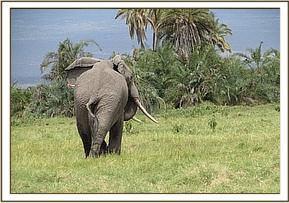

Immobilization, Examination and Treatment
The elephant was immobilized using 16 mgs Etorphine Hydrochloride in a 2cc dart topped up with water. Darting from a vehicle was done using the Dan-inject system. Full immobilization took place after 8 minutes and he fell on lateral recumbence. The trunk was maintained patent by the help of a stick which was placed across the entrance. The ears were used as blindfold. On physical examination the elephant had an infected wound on the left forelimb which could have been the result of a hippo bite. The dead tissue was debrided and the wound thoroughly cleaned using water and Hydrogen Peroxide. It was then lavaged using tincture of Iodine. The bull was injected with 100 ml Oxytetracycline 20% and 50 ml Dexamethasone at different sites intramuscularly. Topical antibiotic ointment and grey clay was then applied to the wound to facilitate healing. The operation lasted 15 minutes.
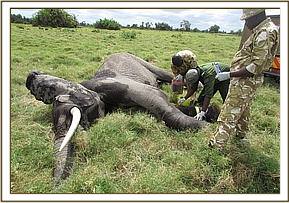
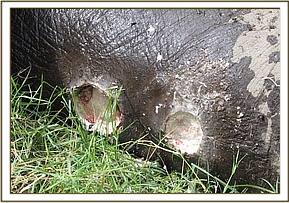
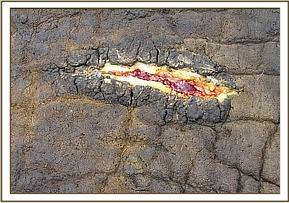

Reversal
Diprenorphine Hydrochloride (48mgs) into the ear vein was used and it took 5 minutes to be fully awake from the anesthesia.


Prognosis
Prognosis is good
CASE#3 TRANSLOCATION OF A PROBLEMATIC ELEPHANT
Date: 6th June 2014
Species: Elephant
Sex: Male
Age: Adult
Location: Elerai Conservancy, Sateo Camp to Tsavo West
History:
This elephant bull, known as Pintail due to his lack of tail, was the second elephant to be translocated this month as they were problematic animals. These animals have posed a major security threat to people as on a daily basis as they invade and crisscross crop farmland.
Immobilization
This elephant was immobilized using 18mg Etorphine Hcl in a 3ml Dan - Inject dart from a Helicopter. The first dart failed to discharge and a second dart was administered after 20 minutes; he was immobilized 8 minutes after this. It took one hour to load the animal into a truck and he was transported by the Emali Road. Unfortunately, the elephant succumbed to death on transit and all attempts to resuscitate the elephant failed. The elephant died due to complications during transport under general anesthesia and had been under for 1 hour and 30 minutes. The tusks, weighing 54kgs and 51kgs, were recovered and safely stored at Amboseli National Reserve Headquarters.

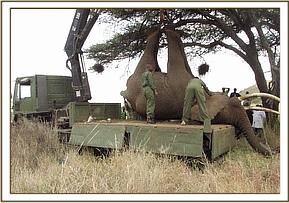
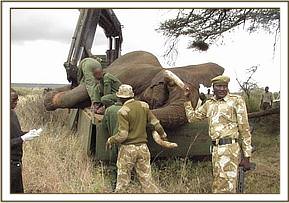

CASE#4 POSTMORTEM OF A BLACK RHINO
Date of Postmortem: 7th June 2014
Date of Death: 5th June 2014
Species: Black Rhino
Sex: Female
Age: Adult (9 – 10 years)
Location: Mukururo, Chyulu National Park
History:
This rhino was among several rhinos within the park and was in good body condition whilst nursing a one year old calf. One evening, at about 6.50 pm, several gun shots were heard within the park so the following morning the investigation team and rangers were deployed on foot patrol. They located the dead rhino and reportedly collected 5 spent cartilages from an A.K 47 rifle about 10 meters from the carcass.


General examination
On examination of the carcass, the following was noted;
- The carcass was in excellent body condition with an approximate body score of 4 on a scale of 1-5, where 1 is poor and 5 is excellent
- The carcass appeared fresh and approximately 2 days old
- Both horns were missing having been crudely removed from the base in a manner that suggested that it was done hurriedly
- The external genitalia and perineal area, appeared to have been mauled by scavengers
Two (1cm diameter) deep penetrating wounds were observed at the thoracic region. One penetrating wound was also observed on the right abdominal area, but the rest of the carcass appeared intact. The rhino also appeared to have been nursing.
On opening the carcass the following findings were noted;
- There was an extensive penetrating wound which had traversed through the body from the right thoracic region.
- On opening the thoracic region about 10 litres of clotted blood flowed from the rib cage and abdominal cavity indicating that the rhino had lost a lot blood via hemorrhage prior to its death.
- The suspected projectile had caused extensive damage to the heart and lungs causing internal hemorrhage.
- Adjacent to the 5th rib, there was also a penetrating wound.
- The projectile and its point of exit could not be identified.
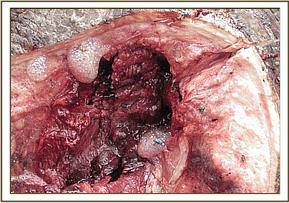

No other unusual findings were detected in other organs and tissues.
Conclusion
This rhino died due to traumatic injuries caused by a projectile object. Of significance was the damage to the lungs and heart causing extensive hemorrhage. The missing horns are proof of human involvement in the death of this rhino that is suspected to have been killed using bullets from an AK47 rifle. RHODIS samples were collected for forensic examination.
A joint operation between Kenya wildlife service, David Sheldrick wildlife Trust and Big life to rescue and treat the orphaned one year old calf is ongoing. The young rhino has been captured on camera and observed to have suffered from a bullet wound on the neck region.
CASE#5 POSTMORTEM OF AN ELEPHANT
Date of Postmortem: 11th June 2014
Date of Death: 10th June 2014
Species: Elephant; named Leila
Sex: Female
Age: Adult
Location: Amboseli National Park
History:
The mysterious death of an elephant was reported within the park by the Amboseli Elephant Research Trust during their normal routine program. This was a case of sudden death as the elephant had been feeding well.
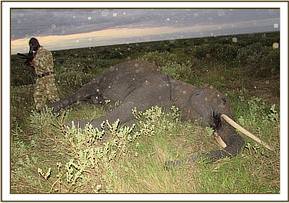

General and Physical examination of the carcass
On general examination, the animal was in a fair body condition and was lying on the left lateral side. No physical injury was observed on the carcass. There was blood oozing from the anus, genitalia and mouth. A decision was made not to open the carcass as the signs suggested anthrax. Blood smears and blood from the ear vein were collected for analysis but the results were free from bacillus rods and any bacterial infection.
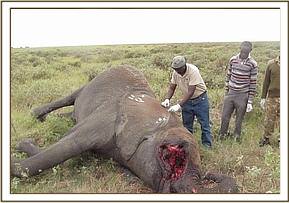

Conclusion
Further postmortem could not have been carried out as the elephant had been mauled by scavengers. The cause of death could have been a viral infection.
CASE#6 TREATMENT OF AN INJURED WILDEBEEST
Date: 11th June 2014
Species: Wildebeest
Sex: Male
Age: Sub-adult
Location: Kitirua, Amboseli National Park
History:
A male wildebeest was spotted by KWS rangers lame and immobile in the Kitirua region. The Veterinary Unit attended to the case immediately.


Immobilization, Examination and Treatment
Physical restraint was applied as the young wilderbeast could not move. On physical examination the wildebeest had no physical wounds and seemed to be suffering from injuries caused during a fight with another animal. The wildebeest’s hind limbs were massaged and 10 ml Dexamethasone Hcl administered intramuscularly. The wildebeest was then released and seemed relieved from pain as it ran towards a herd grazing nearby.
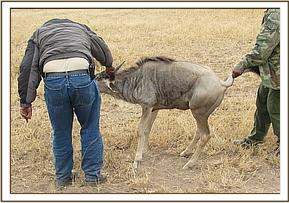


Prognosis
Good
CASE#7 TREATMENT OF AN INJURED ZEBRA
Date: 11th June 2014
Species: Zebra
Sex: Male
Age: Adult
Location: Kimana Sanctuary
History
A male zebra was spotted by rangers at the sanctuary and reported to be lame. The Veterinary Team immediately attended to the case and made a decision to immobilize and examine the zebra.
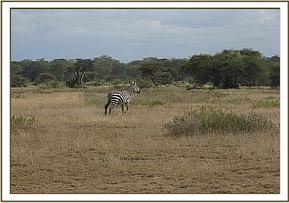

Immobilization, Examination and Treatment
The zebra was immobilized using 7 mgs Etorphine Hydrochloride and 60 mg Zerperone in a 3cc dart topped up with water. Darting from a vehicle was done using the Dan-inject system. Full immobilization took place after 14 minutes and he fell on lateral recumbence.
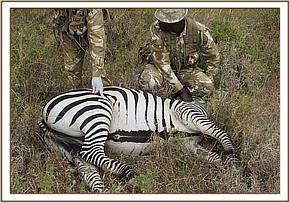

The zebra was blind folded and Opticlox applied to the eyes. On physical examination the zebra had suffered from an open compound and comminuted fracture. An incision into the fracture was made to expose the extent of the injury. Bone fragments were retrieved distal to the hock joint.
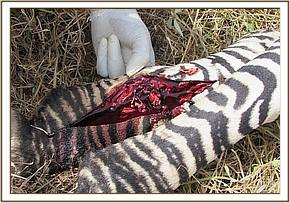

Prognosis
The prognosis was poor with no chance of recovery even with clinical intervention. A decision to euthanize the zebra was made to alleviate suffering. Euthanasia was done using 30 ml Euthanize.
CASE#8 POSTMORTEM OF AN ELEPHANT
Date of Postmortem: 16th June 2014
Date of Death: 15th June 2014
Species: Elephant
Sex: Female
Age: Adult
Location: Intilali, Kuku Ranch
History:
Herders reported to the Kuku Ranch Management after spotting a dead elephant within the area. The management then reported to the Veterinary Team and also dispatched a team of their rangers to the scene. The team found the carcass intact and embarked on removal of tusks for safe custody. The tusks, which weighed 2.8 kg and 3.0 kg, were then delivered to Tsavo west headquarters.
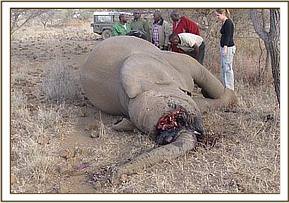

General and Physical examination of the carcass
On general examination, the animal was in a fair body condition and was lying on the left lateral side. She had a penetrating wound to the abdominal region caudal to the umbilical region. The carcass was then placed on right lateral recumbency for further examination. A large penetrating wound (6 cm) was observed on the abdominal region. The wound was probed for any foreign objects but none were found. However the two wounds had a communicating channel indicating the entry and exit points. On incising across the penetrating wound, there was a lot of black tarry blood which had not clotted (approx. 500 ml). The wounds were fairly fresh (about 36 hrs) and had also penetrated into the abdomen. The small intestines had been ruptured by a spear and were also damaged (necrotic). There was also black tarry un-clotted blood around the wound and from the abdomen.
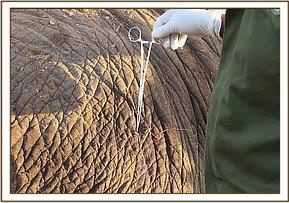

Conclusion
Hemorrhage and the fact that the blood had not clotted (Black tarry) showed that a foreign compound had gained entry via the penetrating wound causing the pathological observation. The tentative diagnosis was poisoning from a spear laced with lethal poison.
CASE#9 TREATMENT OF A SNARED GIRAFFE
Date: 29th June 2014
Species: Giraffe
Sex: Female
Age: Adult
Location: Kimana Sanctuary
History:
A giraffe was reported by rangers to have been spotted with a swollen fore limb within the sanctuary. The veterinary team attended to the case and darted the giraffe for treatment and removal of the snare.
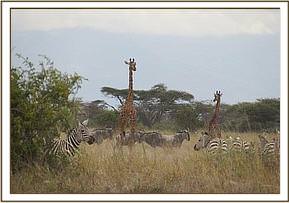

Immobilization, Examination and Treatment
The elephant was immobilized using 13 mgs Etorphine Hydrochloride and 30 mg Azerperone in a 3cc dart topped up with water. Darting from a vehicle was done using Dan-inject system and immobilization took place after 5 minutes. With the use of ropes she was cast down for treatment and removal of the winch snare. On physical examination the giraffe had an infected wound and a winch snare on the right fore limb.


The snare was removed and dead tissue debrided. The wound was thoroughly cleaned using water and Hydrogen Peroxide, and then lavaged using tincture of Iodine. The giraffe was injected with 100 ml Oxytetracycline 20% and 100ml Flunixine Meglumine at different sites intramuscularly. Topical antibiotic ointment and grey clay was applied to the wound to facilitate healing. The operation lasted 30 minutes.
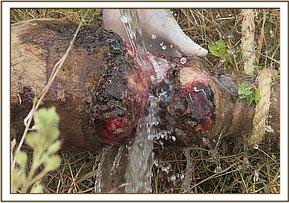

Reversal
Diprenorphine Hydrochloride (42mgs) was injected into the jugular vein. It was then held to the ground by neck region as the treatment continued. The giraffe was then released to join the rest of the herd.
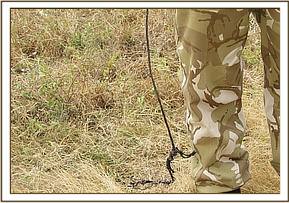

Prognosis
Good.
CASE#10 TREATMENT OF AN INJURED ELEPHANT
Date: 29th June 2014
Species: Elephant
Sex: Female
Age: Adult (25 – 30 years)
Location: Ithumba
History:
The DSWT pilot while on his normal aerial patrols spotted a nursing injured elephant in a herd of about 20 elephants in the Ithumba area. He made a report to Veterinary Team and immediately made plans to airlift the veterinary doctor to Ithumba. On arrival, the elephant was in a bush thicket and proved difficult to locate and dart. However, the elephant luckily moved to a watering point which was on open ground. The injury was accessed and a decision to immobilize the elephant for treatment was made.
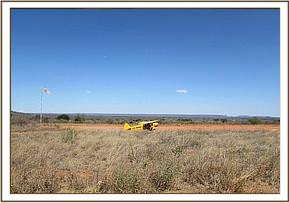

Immobilization, Examination and Treatment
The elephant was immobilized using 17 mgs Etorphine Hydrochloride in a 3cc dart topped up with water. Darting from a vehicle was done using Dan-inject system and full immobilization took place after 17 minutes. The elephant fell in a dog sitting position and the vehicle could not get an access route to the elephant. With the help of rangers on foot, the elephant was pushed to lateral recumbence while the trunk was maintained patent using a stick placed across the nostril entrances. The ears were used as blindfold. On physical examination the elephant had two infected wounds on the right flank region. There was lots of pus and necrotic tissue in the wound. An incision was made across the wounds so as to allow access and drainage of the wound. An arrow head was successfully removed, which was about 1-2 weeks old, and the dead tissue debrided and removed (weighed about 0.75 kg). The wound was then thoroughly cleaned using water and Hydrogen Peroxide and was then lavaged using tincture of Iodine. Topical antibiotic cream and grey clay was applied into the wound to facilitate healing. The elephant was then injected with 100 ml Enrofloxacin 10% and 100ml Dexamethasone at different sites intramuscularly. The entire operation lasted about 35 minutes.


Reversal
Diprenorphine Hydrochloride (54mgs) into the ear vein was used to reverse anesthesia. It took about 4 minutes for her to be fully awake and walk away from the site.


Prognosis
Good
CASE #11 TREATMENT OF AN INJURED ELEPHANT
Date: 30th June 2014
Species: Elephant
Sex: Male
Age: Adult (20 – 25 years)
Location: Lake Jipe
History:
The Tsavo West rangers based at Lake Jipe while on their routine daily patrols spotted a lame and off feed elephant in the area. They made a report to Veterinary Team who immediately made plans to attend to the case. On arrival, the elephant was on open ground and the extent of immobility could be assessed with ease. A decision to immobilize the elephant for examination and treatment was made.
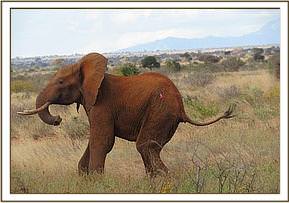
Immobilization, Examination and Treatment
The elephant was immobilized using 17 mgs Etorphine Hydrochloride in a 3cc dart topped up with water. Darting from a vehicle was done using Dan-inject system and full immobilization took place after 7 minutes where he fell on lateral recumbency. The trunk was maintained patent using a stick placed across the nostril entrances. The ears were used as blindfold.
The elephant was carefully examined and the left forelimb was extremely swollen around the femoral tibial joint. There were no external injuries visible. This led to the diagnosis of a femoral tibial joint laxation, probably after a fall or fight with other bulls as this is the mating season. The elephant was administered with 100 ml Enrofloxacin 10%, 150ml Flunixine Meglumine and 100 ml multivitamin injections at different sites.
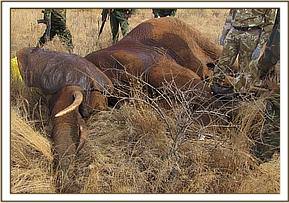

Reversal
Diprenorphine Hydrochloride (54mgs) into the ear vein was used to reverse the anesthesia. It took about 6 minutes to be fully awake from the anesthesia and walk away from the site.


Prognosis
Good
PATROLS AND SURVEILLANCE
The Amboseli Mobile Veterinary Unit also conducted normal patrols and surveillance within the Amboseli ecosystem and the areas involved included:
- Chyullu National Park
- Amboseli National Park
- Tsavo West National Park-Ngulia rhino sanctuary
- Kimana sanctuary
- Maasai wilderness conservation trust
- Mukururo rhino
- Kajiado region
- Namanga region
- Lake Jipe region (Tsavo west)
This was intended for follow up of cases attended to and searching for any unreported cases. During the surveillance an elephant of about 30 years old with a hernia was spotted. However, considering the age, weight, size and risk involved in the procedure for surgical correction, a decision was made to allow the elephant live with the hernia since it was not life threatening.
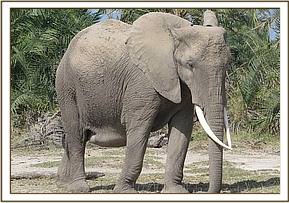

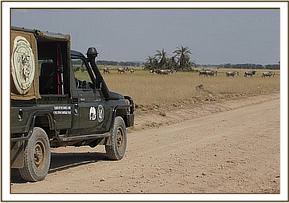
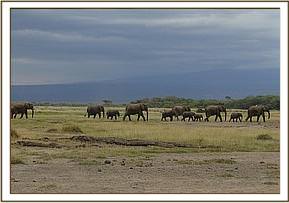
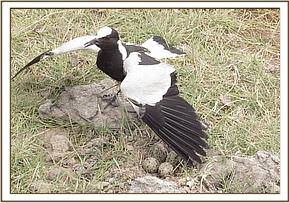

Acknowledgements
The Southern Conservation Area Mobile Veterinary Unit is grateful to all individuals who played a role in assisting us towards achieving our goal. Many thanks to The David Sheldrick Wildlife Trust, The Samuel J and Ethel Lefrak charitable trust and The Kenya Wildlife Service for their continued support to this unit which aims at immediate response to clinical intervention, wildlife rescues and alleviating wildlife suffering.